TANGERINE



A total of 173 Utica University students went through the conduct hearings process during the fall 2022 semester, according to data from the Guardian Conduct Database. During spring 2023, 129 students, equivalent to 7.8% of the total student body, also went through conduct, a decrease from 2021, which saw a total of 477 conduct cases.
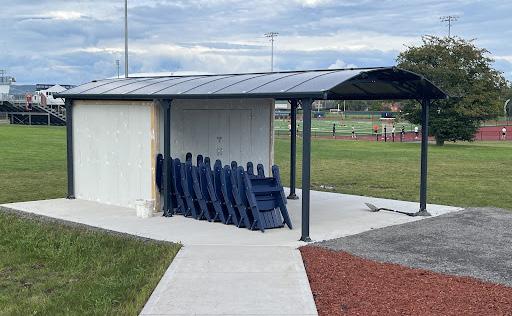
According to Dean of Students Richard Racioppa, the data is anything but atypical, especially with new students joining the campus in the fall.
“Every time we have a new group of students come in, they deal with issues in transition,” Racioppa said. “And with that for a lot of students [it’s] a newfound sense of freedom. Some make great choices, and sometimes they do things that they need to be held accountable for.”
About 5.1% of all conduct hearings in the fall of 2022 were alcohol
and drugs related, a 3.1% decrease from the previous semester.
Carl Lohmann, director of student conduct and community standards at Utica University, said aside from drug and alcohol issues, another cause of conduct hearings on campus was disputes between students.
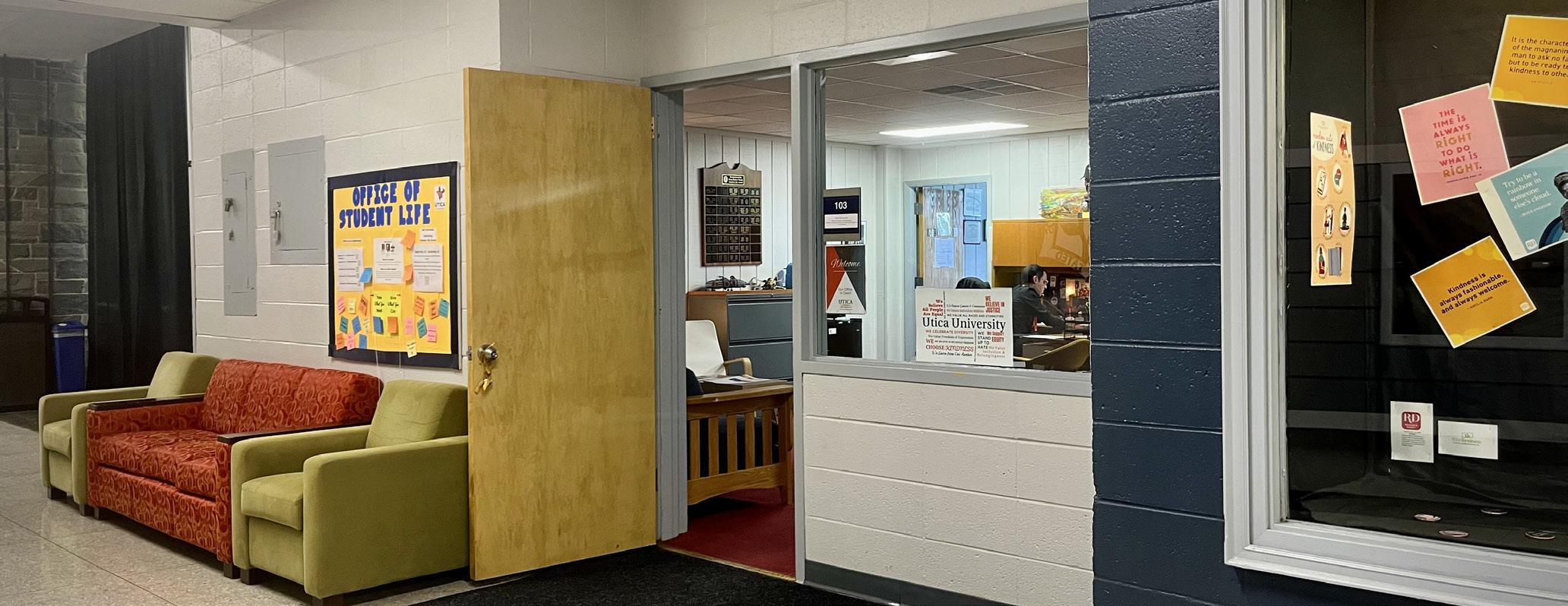

“We try to take an educational approach where we can,” Lohmann said. “[By] trying to coach those involved and give them the tools they need to navigate disputes with roommates, others on the same floor or with people in an off-campus setting.”

Lohmann described
the conduct hearings as a non-punitive process aimed at education and motivation.
“Everybody is capable of making a mistake,” Lohmann said. “We aim to help students understand both what the rules are and the better decisions they could make in similar situations down the road.”
According to Lohmann, to decrease the number of conflicts in the future, restorative hearings will be installed to move disagreements outside the conduct process.
“As long as both parties are agreeable,” Lohmann said. “We take it out of the conduct
process and try to mediate a situation where, whatever the harm was in the conflict, we can resolve it.”
Aiden Moore, a sophomore animal behavior major, was initially taken aback by the numbers.
“I guess it’s just shocking,” Moore said. “Because that is a really high [percentage] of students, and a really big number.”
However, according to Moore, the numbers are not as shocking when considering the incidents that took place.
CON. ON PAGE 3
@Utica_Tangerine
@Utica_Tangerine
Editor-In-Chief - Mickale Thompson
Managing Editor - Diana Sidorevich
News Editor - Selma Dizdarevic

Features Editor - Charlie Buckley
Online Editor - Emma Goodspeed
Multimedia Editor - Kayleigh Sturtevant
Special Assigments - Kayden Lamphere
Sports Reporter - Nick Phillips

Enterprise Reporter - Mariami Kentchadze
Staff Photographer - Luke Reed
Criculation Manager - Juan Garcia

Adviser - Mary Christopher
Letters to the editor are welcomed from all members of the Utica University community. Letters must meet fair and accurate publishing standards and contain no libelous material. Anonymous letters to the editor will not be printed. All letters and editorials must meet the print deadline of 5 p.m. on Mondays. Please send all submissions to tanger@utica.edu. Takeback requests are a form of censorship and therefore not accepted.
The Tangerine accepts paid advertisements. Advertising copy is subject to the same professional publishing standards as content. The Tangerine reserves the right to reject advertising that does not meet the standards established, is libelous, is in poor taste or violates discrimination laws. Please direct all inquiries to tanger@utica.edu. The deadline for publication is 10 a.m. on Tuesdays.
The opinions and columns expressed in The Tangerine are those of the individual writers and do not represent the views of The Tangerine or Utica University.


“In my classes, I’ve heard a lot about different parties and dorm stuff happening. There is a shock effect of hearing that number, but then I realize that I’ve actually heard about a lot of it.”
The current focus of the conduct system, Raccoppa said, is increasing visibility of what it means to be a community member at Utica University.
“We can always do more,” Racioppa said. “We’re always
striving to be better with the process. We want students to know that we’re here to assist them, and we want to lead by example in terms of how we conduct ourselves.”


The Utica University section of the American Association of University Professors (AAUP-Utica) reached a tentative agreement on Sept. 6 which has since been approved by the governing board after working without a contract for more than 200 days.
The agreement will be presented to the voting members for ratification on Wednesday, Sept. 20. The AAUP-Utica chapter represents 178 members and 151 are in good standing, meaning they are dues-paying members and eligible to vote on tentative economic agreements.

According to the bylaws of AAUP-Utica, only members in good standing and persons who were members in good standing as of the last day of the month prior to when the voting period commences are eligible to vote in collective bargaining agreement ratifications. Under the tentative agreement, the economic proposal includes:
Yearly raises and lump sum payments for this year and the next three years
A new minimum salary framework to help [their] most underpaid members


In academic years 2024-2025 and 2025-
2026, additional reimbursement pay added to the base salary for any member whose salary was reduced in 2020-2021 under the July 2020 MOA
Yearly increases to promotional raises, professional development raises (PDC), overload pay, and faculty research funds (FRC)
Stronger language to protect jobs in the case of retrenchment
Clear language codifying bargaining unit faculty members as 9-month employees, and specifying that faculty duties are only required during the 9-month academic year
No cuts to healthcare and no cuts to retirement
“We had to be creative in figuring out how we could satisfy our bargaining unit and take care of the different factions in our bargaining unit,” AAUPUtica President Leonore Fleming said. “With this tentative agreement, I’m very happy with the ways in which we’ve found different strategies to try to take care of different groups.”
The current contract was effective from June. 1, 2015 through to May. 31, 2020, but had been extended multiple times through to Jan. 31, 2023, marking the initial day of AAUP-Utica members “working without a contract” includes all
full-time tenured and tenure-track faculty members, including full-time non-tenured faculty members employed under terminal contracts; academic program directors, coordinators, and department chairs in their capacity as fulltime faculty; librarians and all Higher Education Opportunity Program (HEOP personnel).
Before the voting period, two informational sessions were held on Sept. 13 where members had the opportunity to discuss the tentative agreement and address any questions or concerns.
“We had good attendance [and] very good questions,” Fleming said. “We were able to answer a lot of people’s questions.”
A third-party service will email secret ballots to AAUP-Utica members. The voting process, which requires ratification from the majority of those voting, will be open for one week and will close on Wednesday, Sept. 27 at noon. Assuming the agreement passes the Board of Trustees will then approve the agreement then the paperwork process will begin.
According to AAUPUtica’s website, the agreement is the result of the hard work of the negotiating team, governing board, grievances officers, and everyone in the union leadership, and also a result of the membership uniting as one and standing up to the administration last year.

Alumni and members of the construction management department will dedicate a new patio in honor of John Paul “JP” Ramel outside of Thurston Hall’s side lawn on Saturday, Sept. 30 at noon. The dedication is part of Homecoming Weekend.
Ramel was a senior when he passed away after suffering a stroke during the spring 2022 semester. He was an active member of the construction management program, many recalled, and the Utica University community.
According to Construction Management Department Chair Dimitar Todorov, Ramel was an involved student and achieved many accomplishments, from leading the Student Contracting Association to volunteering as a firefighter.
“We were actually trying to get him to slow down,” Todorov said. “Since he was doing so much. He had so many projects, and was even working parttime at a landscaping company.”
One such project that Ramel had a particular interest in, Todorov said, was the construction
of a patio outside of Thurston Hall.
“Our program has these smokers for the cookouts we do for homecoming and other events,” Todorov said.
“We were told that we needed to move them out of our material labs, and JP’s group suggested building a shed and patio for them.”
From there the project went into a planning and development stage, Todorov said, with many different designs and locations being considered. Unfortunately, Ramel passed away before the project could be completed.
“After he passed, everybody wanted to do something,” Todorov said. “Through donations, primarily from students,
faculty and advisory committee members, we put some money together, and we knew that we wanted to finish JP’s patio.”
Audrey Cross, assistant professor of construction management, played a major role in the development of the patio and highlighted the progress the team has made toward its completion.
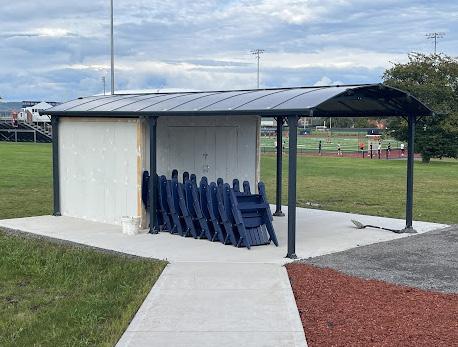
“It started last spring,” Cross said. “The concrete slab was poured and that was it. Then, my colleague [Professor] Randy DeFranco actually designed [the shed and patio], and I, along with everyone else, made it come to fruition.”

According to Cross, most of the progress on the patio was made on the weekend that students first began

moving back into campus, where she planned a two-day long building event.
“We started with literally nothing,” Cross said. “Basically a pile of lumber. We framed the walls, put on the roof and the siding, we had teams working on the pergola, the framing, painting; we all had an integral part in making it what it is.”
All that is left to complete the project, Cross said, is the final coat of paint and the installation of the dedication stone for Ramel along with perennial flowers that will be planted around the memorial plaque stone.
Todorov thanked Ramel’s friends and classmates who came back to work on the patio and said it was a way to really bring the community together.
“For us, it’s a way to remember him,” Todorov said. “A place for us to come together. It’s what he was working on, and we’re happy to have finished it for him.”

The Health and Wellness Center launched a new campaign this summer called the Red Folder program. The initiative provides a way for faculty and staff to better assist students who may be showing signs of distress. The program originally started at the University of California in 2012 and since then has reached universities across the country. It was brought into Utica University before the start of the fall semester after reports that faculty and staff seemed “kind of lost” when it came to responding to the mental health of students.
“It was started to give faculty and staff a simpler way to help students that are in crisis,” said Maria Klosek, a clinical counselor at the Health and Wellness Center. “We did some research over the summer and saw that this program was at universities all over the country, so it made sense to bring it here to Utica University.”
The folder is structured in three main parts: recognize, respond and refer. Faculty and staff can recognize signs of distress through different indicators such as behavioral, cognitive, emotional and physical signs.
“The big thing with the folder is the three R’s,” Klosek said. “I think for a lot of staff, especially if you’re not too well versed on mental health and different symptoms that someone may display when in distress, you might not be able to recognize it. So, that’s the first step, recognizing the different ways that a student can be in distress.”
“If a student is acting out of the norm, it probably means that something’s going on,” she added.
After recognizing the situation, faculty and staff must respond proactively and in ways that show support for the student. While it might seem “pretty simple to respond,” the Red Folder provides a detailed guide to responding both calmly and directly.
“A lot of times we’ve heard that some professors have had students come to their offices and just broken down,” Klosek said.
When addressing concerns for a student’s health, faculty and staff can follow a simple, color-coded guide to help them refer students to the proper resources.
“There’s different levels to the crisis. Green might mean you’re not really concerned about the student so you refer them to the Health and Wellness Center,” Klosek said. “We have the referral online, it’s totally anonymous.”
The decision guide progresses from low to high concern. The middle yellow box signals an uncertainty about the student’s wellness, which warrants a call to the Health and Wellness Center. The final box in red is for students in immediate need or danger, in which faculty and staff should call 911 or campus safety.
In both yellow and red cases, a report should
be made from the staff member to the Behavioral Intervention Team or BIT.
According to Ariel Rios, executive director of the Health and Wellness Center, BIT is composed of different campus leaders who work together to connect students to the proper resources.


“We meet as a team,” Rios said. “Members of the campus community like the dean, campus safety and [Student Living and Campus Engagement], and students can be brought up in the Behavior Intervention Team to make sure that they’re linked to appropriate support.”
In addition to the Red Folder program, the Health and Wellness Center offers free and confidential counseling services. To access the Red Folder PDF and learn more about the campaign, visit the dropdown menu at www. utica.edu/directory/ health-and-wellnesscenter.
 ◊ DIANA SIDOREVICH MANAGING EDITOR
◊ DIANA SIDOREVICH MANAGING EDITOR
Utica University
welcomed 745 incoming students this semester. Among the newly enrolled students, 72 were international students which brought in new backgrounds and cultures to the campus.

Elizabeth Nassar said the increase is the result of a tri-fold strategy to increase international enrollments.
Utica used educational consultants to increase the quality of applicants, strongly emphasized graduate programs, specifically the MBA program and worked one-on-one with students to prepare them for visa interviews.
The university’s visa approval rate has increased almost 20% worldwide over the last year which has helped boost its global presence.
Studying overseas is a big investment considering international students receive little to no financial assistance nor have the opportunity to earn money in the U.S., Nassar said. The application process itself can take several months.
Once students find a university with their program, the university works with students on obtaining proper documentation and meets virtually with students to prepare them for the interview process.
Nassar said after COVID, international education
became more interesting to people from abroad.
“I think that international students in general, whether they’re scholars, whether they’re undergrads, whether they’re graduate students, really understand the value proposition of Utica University in a way that they might not have a couple years ago,” Nassar said.
Why international students choose Utica
Cost, quality of faculty, the ability to do Curriculum Practical Training or Optional Practical Training and being close to New York City and Boston are several of the benefits, Nassar said.
Anjli Sharma, a graduate student from India, has studied at Utica for three semesters. Prior to applying for grad school, she worked as a subject matter expert for British Telecoms in India for six years. Most international students enrolled in the MBA program have an
average of five years work experience.
Being overseas brings employment challenges as most students are limited in the amount of hours they are allowed to work. Some campus jobs can be filled with only Federal Work Study students.
Student Zill Bhavsar from India says there is competition for jobs among international students.
“They don’t have enough jobs for us, because most jobs they give to students who are citizens here,” Bhavsar said.
She said professors have been really helpful being references as they look for work, but in addition to campus having limited job availability, they have the added challenge of lacking transportation to get to work.
“Utica is very car-centric and the transportation system is very bad,” Bhavsar said. “I would
recommend them to consider us for campus jobs because we are a lot of international students and jobs are very less and provide us with shuttle services too, to downtown and stores, and not just to downtown classes.”

Sharma was accepted to three universities but chose Utica because she was looking for an in-person experience.
Among her options were a university in Boston and a university in San Francisco, but Utica had the small town appeal. Sharma was looking for a walkable city where she could get to know the people in the community she would be a part of.
Assimilating into American culture is challenging
International Student Union President Mariami Kentchadze said one of the biggest challenges is culture shock.

CON. FROM PAGE 7
Kentchadze came to Utica from the Republic of Georgia right out of high school and is now a senior in the Cybersecurity program.
“It’s really hard to get used to societal norms and expectations,”
Kentchadze said, “That people don’t talk about but expect of others because that’s the environment they grew up in. You restart your life from zero and you don’t know people. You have no ground to stand on.”
Kentchadze said all of the context one learns in their life in their country of origin, like which streets are safe at night, which cafes are good, which products and grocery stores work for
you, are void because the context changes.
Many international students also find it more difficult to connect with their families at home due to time zone differences. Utica’s campus becomes a primary community for international students.
Sharma said from her first semester in spring 2023, faculty and staff have been flexible and accommodating with the technological adjustments she had to make as a student.
“Staff is actually very very understanding and take the time to make us understand things that we are not understanding,”
Sharma said.
She spoke of Nurse Dawn DeGironimo at the Health
Center who has helped international students with challenges they face while adjusting to a much colder climate than where they came from.
Although the majority of the campus supports the international community, Kentchadze said some campus offices have an expectation that international students should only be handled by the international students office. She said it would be better if offices worked together to support international and minority students on campus.
Students can support their International peers by connecting with them and keeping an open mind, according to Kentchadze.


“Don’t be annoyed when
international students don’t have the context for something in American culture, clarify a little more,” Kentchadze said. “Be respectful about people’s speech and if they are mispronouncing things or don’t know a word, help them, help them and support them. Don’t have expectations that you would have for American peers, and give them time to adjust to their new life.”
Incoming students came from Afghanistan, Bangladesh, Bermuda, Canada, Cameroon, Ethiopia, Finland, Ghana, Hong Kong, India, Japan, Kenya, Lebanon, Malaysia, Myanmar, Nepal, Nigeria, Pakistan, Poland, Russia, Spain, Sweden and Wales.
Many people envision their future careers a certain way growing up. However, some take a different path that changes their original aspirations, and things turn out how they were meant to be. Dr. Nicole Lawrence, assistant professor of English at Utica University, is one of them.
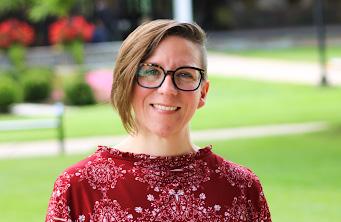
Lawrence, who is new to Utica, said over time her love for biology began to shift from the ocean and more towards pre-med. In her freshman year of college, she failed chemistry, one of the first classes she had ever failed. At that moment she realized she had been running away from her natural talent for reading and writing, which was the true path she was searching for.
She then transferred to the University of MassachusettsAmherst.
“I picked up an English major and a double major in women’s studies and started reading and writing from there,” Lawrence said.
Lawrence, a firstgeneration college student at the time, didn’t understand how college
worked and spent most of her undergraduate years figuring it out. Once senior year rolled around some of her professors suggested that she go to graduate school.
“They said I should go to grad school for an M.F.A. since I had a concentration in creative writing,” Lawrence said. “But I had bills to pay so I needed to get a job, so I had three jobs while I was in college. One of them was being a barista at Starbucks which ended up with me becoming a store manager for Starbucks. I wore an apron for over 13 years.”
After working for some time, Lawrence returned to grad school to pursue a creative writing/poetry degree at the University of East England. While there an employee asked her if she could edit one of their admission applications then suggested Lawrence apply, and she did.
“I got a degree in poetry, but I realized that I didn’t really want to be a poet, I was more interested in the critical studies of literature,” Lawrence said. “So when I moved back from the United Kingdom after grad
school, my partner was still going to grad school at the time.”
They both moved to Chicago where she continued to run a Starbucks store for another five years while her partner finished grad school. Lawrence furthered her education by going to Rutgers University in Camden for a master’s degree in literature, which eventually led her to attend the University of Connecticut for her Ph.D. in literature.
After earning her doctorate degree, she started a teaching job at Blackburn College, located in the south-central area of Illinois. However, she eventually began looking for a new job and heard about Utica University.

“When you’re looking for a new job position in literature, a list of jobs may pop up but some just don’t fit you,” Lawrence said. “There were a few British literature jobs and I applied to ones that were on the East Coast.”
The thing she liked most about Utica University is that the school’s population isn’t too tiny but also not too big.
Lawrence currently teaches a class in 18th Century British literature that allows students to read some of her favorite novels, including Mary Shelley’s “Frankenstein” and Oscar Wilde’s “The Picture of Dorian Gray.”
“I think that while Dorian Gray is considered British literature, it’s also LGBTQ literature as the protagonist of the novel is gay,” she said.
Lawrence explained that while the Frankenstein
and Dracula characters aren’t necessarily considered “queer,” they have undefined characteristics or just an overall in-between likeness about them that she finds fascinating and compelling.
“I like working with those texts with students because they are also quite challenging texts,” Lawrence said. “I think reading old literature can be really challenging for some people, but the themes are surprisingly modern such as feeling different or feeling like you don’t fit in with others.”

Lawrence said one thing that stands out to her since moving to Utica is the food.
“My experience of moving from a small community with only about ten restaurants to a place where I can basically eat my way through the town is kind of a wonderful experience,” Lawrence said.
Lawrence said one piece of advice she can give to those who want to teach English is to spend time finding what it is you love about literature.
“Find what connects you to certain types of texts. I didn’t realize I liked British literature when I was in undergrad,” Lawrence said. “I kind of avoided it cause I had a bad experience within my British literature class, so I didn’t start to really look at British Literature until I was in grad school and that’s when I realized the text we read in British Literature are often very strange and weird, but also perplexing.”
Dr. Nicole Lawrence ‘didn’t want to be an English person’ then realized her true pathDr. Nicole Lawrence developed a love for biology before finding the true talent. // Photo: Luke Reed
Clubs on campus offer ways for students to connect through different hobbies and activities, but clubs such as the Jewish Student Union and Asian Student Union help students connect, learn, and share cultural experiences.


One organization, the Black Student Union was started by a group of students who felt they weren’t being heard in the campus community. Leah Griffin, a junior biology major, was recently elected the new president of BSU and is making sure the organization creates an impact on campus.
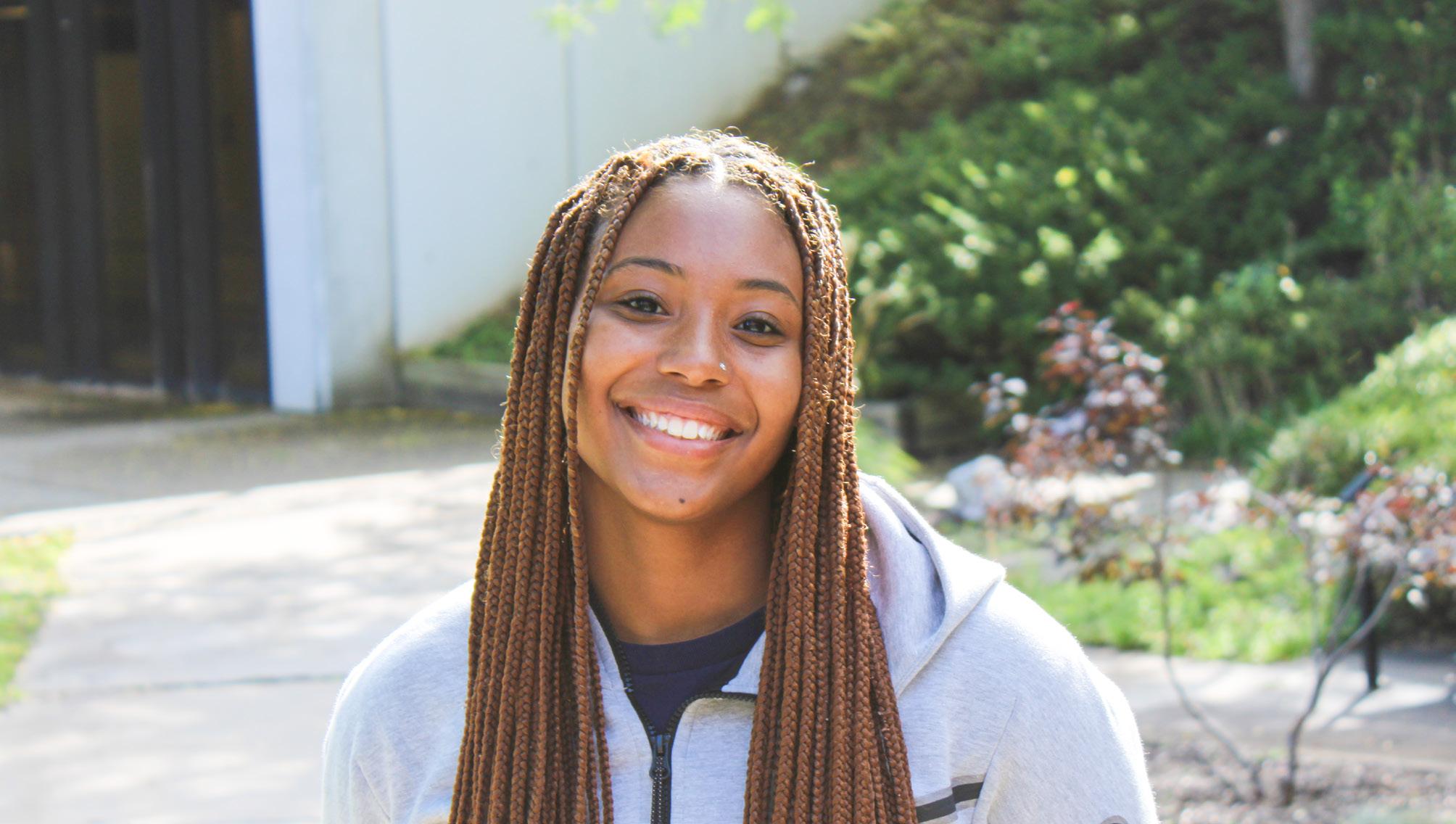
“[That] was during a time that wasn’t great for people of color,” Griffin said. “So they joined together to form the Black Student Union and it was officialized as a club in 1969.”
Griffin said during her first year, she didn’t become involved in clubs until the spring semester and was encouraged by her friends to join BSU. At the first meeting, she said she wanted to help the former president of BSU, who was delighted as COVID had taken a toll on the organization and other clubs on campus.
“The numbers had decreased so the president was trying to get as many people as they could to join BSU,” Griffin said. “As a Black student myself, I wanted to join the [organization] as I felt it was a very belonging community.”
Griffin began to get involved more with many
of the club’s events shortly after her first meeting and by the end of the semester, she wanted to be a part of the Executive Board.
“During my sophomore year, I was the treasurer for BSU,” Griffin said. “And it was then I started to really take on a role and host events.”
As treasurer, her main responsibilities were keeping track of the club’s finances and working with the Student Government Association Finance Committee in planning big events.
When elections came around for the next BSU E-board, she was nominated as the new president of the Black Student Union.
Griffin said one of the biggest impacts she wanted to make was getting people involved. She and the E-board decided to become orientation mentors to show that not only was the
club active, but to interact and meet the incoming students.
“Engagement is really important for the university because it’s been down for so long,” Griffin said. “Now with 592 first-year students, engagement is up.”
Griffin said she wants to raise awareness of things that happen both within the campus community and outside of it.
“I want to bring social awareness to people,” Griffin said. ”That’s why we tend to do historical events and academic events where students can learn more about Black history, the injustices happening and bring the community together.”
With some major events planned for the year, including the Rep Your Flag party during Homecoming which gives students a chance to show off the different flags that represent their heritage and culture the organization also will
hosts the annual Kwanzaa holiday which takes place in December along with the annual Apollo Night talent show hosted every spring.
Griffin hopes that by the time she graduates next year, BSU will have new students thriving as a community.
Mark Kovacs, the executive director of Diversity, Equity, and Inclusion and coordinator for community relations is the advisor for BSU and said he believes she can achieve this vision.
“Knowing and seeing how much she got involved I thought she was the perfect choice,” Kovacs said. “I think her approach to social awareness is great, one of the things she’s always said to me is that the black student union isn’t only for students of color but for allies as well as people who support social justice.”
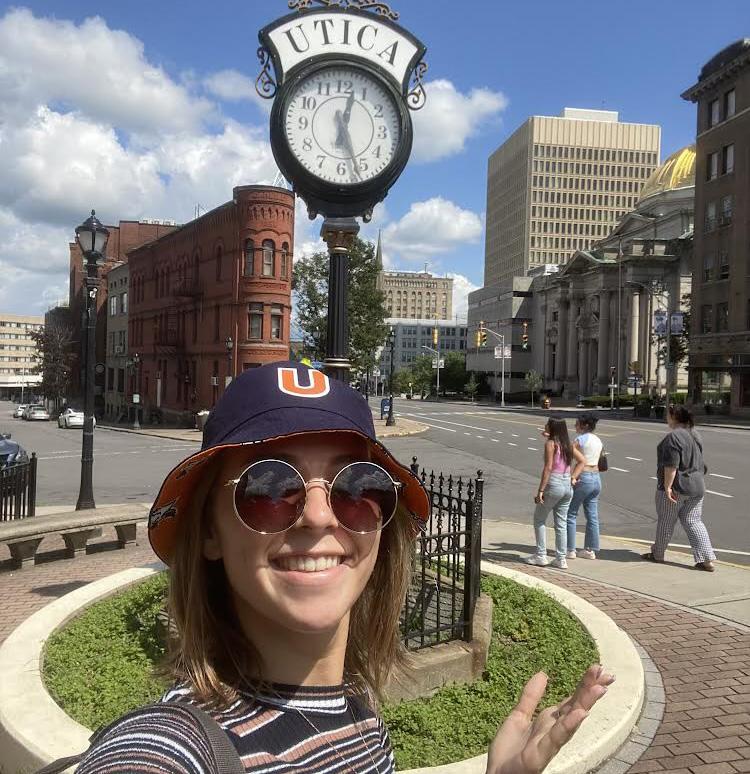


Since coming to the U.S. from Poland a couple of weeks ago, the amount of things that blew my mind has been extraordinary.
Everything from the lifestyle, attitude, and habits to food and temperature preferences, has been an adjustment.
The question I get most is, why Utica? The truth is, the choice has been kind of out of my control. But to be honest – I do not regret this a tiny bit. I realize that this upstate, far-from-the-city kind of town lets me experience the true American lifestyle – nothing fake or fabricated, simply a perfect representation of the Northeast.
One of the first things a European would find striking is the omnipresent fleet of cars. The streets are not built for pedestrians, the crosswalks are too few and the distances are too great. Being an exchange student with no access to a car at any time makes you feel small and overwhelmed, and the lack of public transportation doesn’t help. Over the next couple of months, I will possibly single-handedly and financially support most Uber drivers in the area.
As far as food goes, I have found that coming home with an additional few kilos is unavoidable.
Not only is Utica famous for its food, which makes the temptation much stronger, but never before had I seen snacks such as deep-fried Oreos, funnel cake, or mac and cheese. Eating those felt as illegal as however many calories I ingested that day at the New York State Fair. Yet, I had such a great experience there with my new friends, that I can’t help but smile about it.
The people are what make or break any exchange experience. I am fortunate enough to say that with my friends I have not been disappointed. I came with no expectations, only high hopes and more than a touch of uncertainty. I count myself lucky to have found both American and international companions here, people who match my energy and are keen on looking for new adventures. We can have hours-long conversations about the differences and similarities of cultures, various points of view, and outlooks on life.
That is what I most wanted to experience here – a true cultural exchange with not only Americans but also with people from all over the world, which I feel represents the diversity in the U.S. extremely well.
Experiencing dorm culture has been the biggest adjustment. It was previously a very movie-esque concept
for me. This lifestyle is a unique mix of personal and academic life, creating a spectrum of the chance to live, sleep, eat, study, exercise, and have fun all in the same place, with the same people. It makes you feel as if you are on a 4-yearlong summer camp. What I love here is how personal and intimate it all seems to be. As a student, you aren’t made to feel like you are part of an anonymous and unimportant mass. The staff, faculty, and students around you genuinely care about you. Sometimes it’s the simple acts of smiling and greeting somebody while passing, holding the door for a stranger, or striking up a casual conversation with someone new. The feeling of unity stemming
from shared experiences makes you feel like you belong, whether it’s going to cheer for our sports team or proudly wearing merch.
The experience is one of a kind. You are missing home, feeling overwhelmed and stressed, having trouble adjusting to cultural differences, all the while having one of the absolute best times of your life. This adventure has already done so much for me, opened my eyes to a whole new world out there, and put certain things and beliefs into perspective. I simply cannot wait to see what lessons the next months bring, and what other memories and stories I’ll be able to tell for the rest of my life.
◊ ELEANOR BERKHOUDT CONTRIBUTING WRITER
Did you know that Utica University’s original mascot was an actual Pioneer, a man dressed in a racoon-skin hat holding a rifle? Or that the Sports Dome is one of the largest athletic domes in North America? Utica University is filled with a unique history. Here are some facts that may surprise you.


When Utica University, originally Utica College, first opened, its campus was located in the basement of Plymouth Church at Oneida Square in Downtown Utica. The institution was established as an extension of Syracuse University which students attended for two years before being required to complete their junior and senior year at Syracuse University. The campus moved to Burrstone Road in 1961 then gained independence from Syracuse University in 1946.
Trax the Pioneer Moose became Utica’s mascot in the fall of 2003. Prior to that, the mascot was a Daniel Boone like figure. The Pioneer remained Utica’s mascot for 51 years until the
institution deemed it racially offensive and politically incorrect due to Native American stereotypes.
“Trax the Pioneer Moose” became the new mascot because moose were indigenous to the area, particularly northern New York.
In the 1960s when the drinking age in New York was 18, there was a bar located on campus called The Pioneer Pub in Strebel Student Center. A 1968 Tangerine letter to the editor praised the institution for strengthening unity among commuter and residential students.“With beer running at the tremendous cost of 20 cents, commuters and dormies can finally get together and have a good drink while promoting school spirit,” the letter stated. The pub was replaced by a pizza parlor called “Itza Pizza” in 1985 when the legal drinking age was raised to 21.
Many of the sculptures that can be seen around campus are the work of Utica’s longtime artistin-residence Henry DiSpirito. DiSpirito was a stonemason who came from Italy. Being an artistin-residence, he served as a sculptor on Utica’s
campus from 1963 to 1995. Utica’s permanent collection of his works include a sculpture called “The Athlete” located in front of the Athletic Center and “The Unfinished Tiger” on the lawn of DePerno Hall.
The annual celebration referred to as Squirrel Day has taken place on campus since 2015. The tradition started after a portion of the Burrstone campus experienced a power outage disrupting everything from classes to food service.The power outage was caused by a squirrel, dubbed “Sparky,” who chewed through electrical wires. Students then began referring to the anniversary of the event as ‘Squirrel Day’ to honor the deceased squirrel.
The New York Sash Teddy Bear Toss is an annual event hosted by the men’s hockey team in which fans bring stuffed animals that are thrown on the ice after the Pioneers score their first goal of the game. Players then skate out to collect the stuffed animals for donations. Thousands of stuffed animals are distributed to local charities. The event is typically held during December at the Utica Memorial Auditorium.
The Todd and Jen Hutton Sports and Recreation Center is the second largest facility of its kind in North America. It stands 270 feet wide, 500 feet long and 82 feet high. Construction on the sports complex was completed in 2015. It features an eightlane, 200-meter NCAA competition indoor track, four multi-sport courts, a multi-sport artificial turf practice field, weight area, locker rooms, equipment checkout area and a concession stand.
The K. Della Ferguson Women’s Resource Center (WRC) is a longstanding organization located in the Francis A. Wilcox Intercultural and Student Organization Center on campus. It is runed by trained student advocates and volunteers focused on developing resources and programs surrounding issues of reproductive justice, sexual health, gender equity, empowerment, racial justice, cultural celebration, current events and domestic and sexual violence. They hold annual events such as Guess Who’s Coming to Dinner and the Women’s Herstory Month Luncheon.

Ready for a run and walk? Join the Utica University students, faculty, staff and alumni on Sunday, October. 1, 2023 at 9:00 p.m. for an ejoyable run/walk arounfd campus. Runners will recieve a t-shirt and a light refreshments. Pre-register for the event by September 24 for a fee of $25 and $30 if registered on September 25 to Ocotober 1, 2023!



Sean Behan, former head coach of Medaille University men’s lacrosse team, has been appointed the new head coach of Utica University men’s lacrosse program.
Behan’s appointment comes after SUNY Cortland on Sept. 7 announced Lelan Rogers, who coached Utica during the 20222023 season, as their new men’s lacrosse head coach.
Behan, a Utica graduate, played lacrosse for four years where he appeared in 48 games and helped the Pioneers achieve a record nine-win season in 2013. He went on to earn a bachelor’s degree in criminal justice with a concentration in economic crime investigation in 2015 and later that year joined the men’s lacrosse coaching staff as an athletic assistant. While coaching Behan earned his master’s
degree in financial crime and compliance management in 2018.
Behan coached Medaille for two seasons before its closure on Aug. 31, 2023. Shortly after he became an assistant coach at the College of Saint Rose before being named Utica’s new men’s lacrosse coach on Sept. 14.
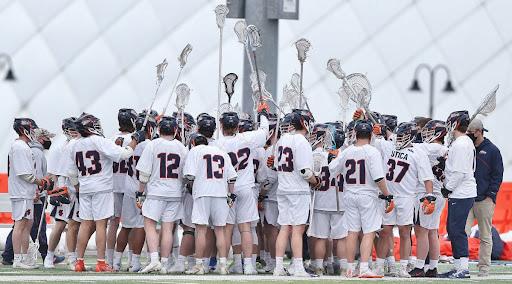
He described returning to his alma mater as
the head coach of the program he once played for as a “dream come true.”
“The opportunity to come back to the place where it all started is extremely special to me. I am excited to get to campus and start working with the administration, coaches, and players,” he told The Tangerine. “Utica provided not only a great education and


an opportunity to play at the next level for me but also the opportunity to begin my passionate coaching career. I am looking forward to returning the favor.”

Utica women’s lacrosse head coach Kristin St. Hilaire will be inducted into the Upstate Lacrosse Foundation Hall of Fame on Oct. 22. She will be joined by six other local lacrosse players at the Induction Ceremony dinner at the Links in East Syracuse.



St. Hilaire said she is truly humbled and honored to be inducted as lacrosse has been a passion of hers for as long as she can remember and has changed the trajectory of her life, molding her into the person she is today.
“To see my name alongside some of the legends of this sport is incredibly special,” St. Hilaire said. “This recognition also allows me the opportunity to reflect on all of those who have supported me throughout my career. Without the hard work, dedication, sacrifices, and unwavering support of my teammates. coaches and family, none of this would have been possible.”
St. Hilaire in her 16th season as head coach has a record of 12991 making her the winningest coach in program history and currently sits on a streak of eleven straight seasons with a winning record.
Before coaching, St. Hilaire was a star player
at the University of Massachusetts where she played from 20022005. During that span, she went on to set school records for forced turnovers, ground balls, and draw controls. It was during this time that St. Hilaire had a lifechanging moment in her lacrosse career.
Her favorite career moment came in 2003 when she was playing at UMass.
“We were in the Atlantic 10 Semi-final game against Richmond, down seven goals with eight minutes to go. We came back and tied the game with 28 seconds left, sending us into overtime. In the OT period, we scored with 48 seconds remaining, sending us to the championship game and capping off an improbable comeback,” she said.
“We stuck together and never doubted our abilities, it was a true team effort. I love telling my current players that story whenever they think any hurdle is too high to overcome, on or off the lacrosse field. I still use that comeback as motivation in my own life when things get tough.”
In light of her accomplishments, some players that described her the best were senior midfielder Katie Crofoot and junior midfielder/ attacker Grace
Stuhlman.
“Coach St. Hilaire’s induction to the Upstate Lacrosse Hall of Fame is very well deserved. Not only is she a great coach on the field but also off the field,” Crofoot said. “She pushes us to be better and dig deeper in all aspects of the game and life. She is willing to do whatever she can to help turn us into the player she knows we can be.”
Stuhlman said she feels lucky to have been coached by such an accomplished player.
“She has helped me improve my lacrosse IQ, and make smarter decisions on the field,” Stuhlman said. “She makes the program feel like a family and I’ve met some of my best friends playing lacrosse here at Utica thanks to the atmosphere she’s created.”
October looming means one thing: the Utica University men’s hockey team will be hitting the ice again soon at the Utica Auditorium. This year brings some unfamiliar faces. With 10 new additions a new beginning will embody this men’s hockey team this season.
After key players graduated, such as Captain Dante Zapata and Justin Allen, a load of players from the Ontario Junior Hockey League (OJHL) and the North American Hockey League (NAHL) joined the program this season. Both leagues are known for developing players of high skills. Many players from the NAHL spent time in its south division, known for its tough nail games. There’s no hiding that in the NAHL south there’s a good chance you’ll find yourself dropping the mitts at some point — just how head coach Gary Heenan wants his guys to play.
Utica will be missing some key players in standout defensemen Jayson Dobay and fellow blue liner Joey Berkopec who did not return to Utica. Both abandoned their senior seasons and signed contracts in the East Coast League.
Losing Dobay hurts a lot. A smooth skater, the defenseman hit a careerhigh 37 points last season (5 goals and 32 assists) in
just 27 games and was set to be a key player for the Pioneers this season. His absence along with Berkopec will be felt, but with a roster of guys that are a couple of seasons in, ready to take over the group has a different style than we’ve seen from Hennan’s skaters before meaning —they skate — compared to the hard nose power forward style that was less about the skating, more about hard on the puck, heavy on shots, and strong around the net, just out muscle the other team.
The game has changed. It favors creativity, speed with the puck, and puck possession. Though it’s hard to judge incoming freshmen, two additions that stick out the most are Dante Spagnuolo and Ethan Roberts. Spagnuolo, a fifthyear player, played two seasons at Adrian College where he won a national championship
in 2022. Roberts, a goaltender, joined the Pioneers after one season with the University of St. Thomas (Division 1). Guys like Shane Murphy, Josh Kagan, Jake Berault, Chris Caroll, John Gutt, and Krostian Acosta are all fluid skaters who should take off this season and carry the new style to the Pioneers.
The schedule also sees an uptick with newer competition. On Oct. 20 the Pioneers will kick start the season at home in an exhibition against the United States Under-18 development team. Next, they host the Adrian Bulldogs twice in a twogame series.
Pioneers will face Oswego State, Elmira, and St. John’s University for the Delta by Marriott Thanksgiving Tournament, followed by the annual New York Sash Teddy Bear Toss at home. This year they face a newly appointed
Division 1 team in Stonehill College. A trip to Oswego comes next where they face the Lakers again on Dec. 9
While there’s a lot to look forward to, there’s a lot to improve. The team has underperformed in the last two years after falling short in the NCAA first round two years in a row against the same opponent. Expectations may be lower now, but this team does have the caliber to climb over the hump.
With SUNY Brockport and Geneseo joining the United Collegiate Hockey Conference (UCHC) in 2024, Division 3 hockey this year is pivotal for Utica. They need to make a statement in these outof-conference games by being a different team on the ice. With a chip on their shoulder expect some noise to be made with the team this season.


